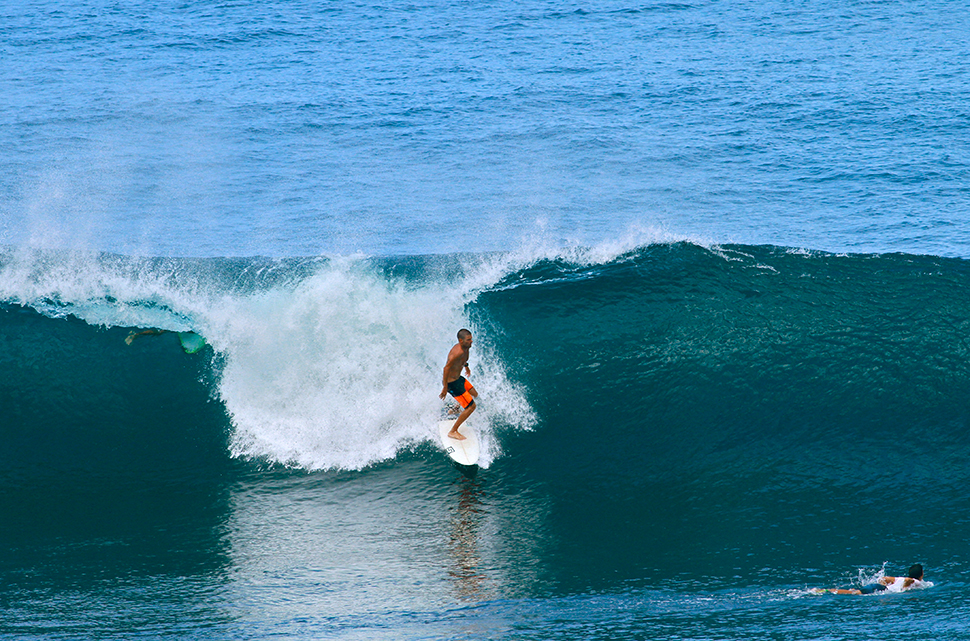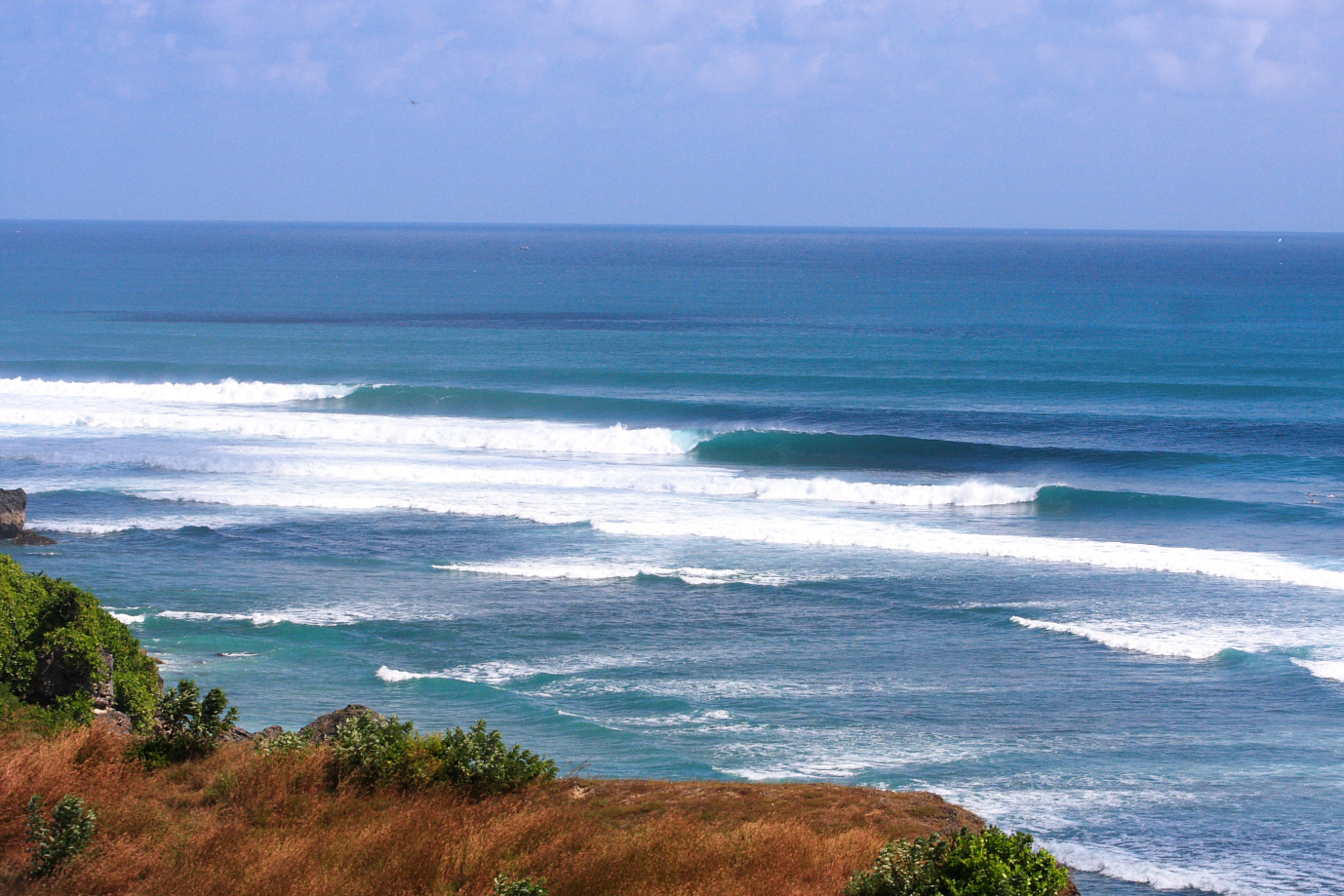Uluwatu / Indonesia – Surf,Bodyboard – Bali – Bukit – West Coast

 Surfergalaxy
Surfergalaxy 
| Wave | Left pointbreak |
| Ola | Izquierda |
| Wind | SE - ESE |
| Tide | Medium - High |
| Marea | Media - Alta |
| Swell | SW - SSW |
| Bottom | Coral Reef |
| Fondo | Arrecife de Coral |
| Time of year | From April to October |
| Época del año | De abril a Octubre |
Uluwatu is one of the biggest left point breaks in the world and therefore has very distinct and well-known sections. There are three main ones, Temples, The Peak and Racetracks.
Temples is the first as it’s just in front of the Uluwatu temple. It’s fast and hollow and isn’t easy to position yourself in the take off zone, you’ll need to be aware of the set, and it’s better from mid to high tide. There is a wave called Bommies which only appears occasionally. It’s a wave that can get a lot of size and breaks the furthest from the reef, you’ll see it between Temples and the Peak on big days.
The second wave, The Peak, is a very consistent left that works better with high and mid tide. It’s a funny peak with different take off zones and occasionally gives a short right just in front of the beach. Sometimes with the right orientation and tide, The Peak creates the Inside Corner barrel, some know of its dynamism and how to link with the next section, known as Racetracks.
Racetracks is the last one, an incredible peeling wave with mid to low tide which offers shallow barrels and fast sections. It’s the most dangerous and it isn’t recommendable for most to surf it with these conditions because it’s very shallow. However, there are opportunities with a rising mid tide when it’s much more surfable.
There is another section called the Outside Corner which needs 8 feet for it to work. It’s located on the outside of Racetracks and with epic conditions it’s considered world class. It can sometimes reach up to 15 feet and is the wave that holds the most size in Uluwatu.
Due to its tradition, many surfers believe that Uluwatu is a wave for all levels and this is not so. In recent years accidents in Uluwatu have become more numerous, lots of them are with mid size high tide because there are many who can’t find a way out of the water because of the strong currents that are generated next to the cliff.
Uluwatu es uno de los Pointbreak de izquierda más grande del mundo y por ello posee secciones bien conocidas y muy distintas. Hay tres principales, Temples, Peak y Racetracks
Temples es la primera, justo enfrente del Templo de Uluwatu, funciona mejor con la marea de media a alta, es rápida, hueca y hay que estar muy atento a la serie en la zona de take off porque es muy cambiante. En ocasiones aparece Bommies, una ola que recoge mucho tamaño, si hay un swell con más de 6 ft empezará asomar a lo lejos entre Temples y el Peak.
El Peak es la segunda ola, una izquierda muy consistente que funciona mejor con marea alta y media. En ocasiones ofrece una corta derecha justo delante de la playa. The Peak es un divertido pico con distintas zonas de take off, a veces con la correcta orientación y marea aparece el tubo del Inside corner, algunos lo conocen y saben enlazar con la siguiente sección conocida como Racetracks.
Racetracks es la última sección, una cremallera que con marea baja ofrece tubos secos y rápidas secciones, pero también es muy peligrosa y por ello no recomendable para la mayoría surfear aquí con la marea demasiado baja, sin embargo, con marea media y subiendo ofrece oportunidades y es mucho más surfeable.
Existen otra sección llamada Outside Corner que necesita 8 pies para funcionar, se sitúa en el outside de Racetracks, con condiciones épicas es considerada una ‘World Class’, puede alcanzar alguna vez hasta 15 pies siendo la ola en Uluwatu que más tamaño aguanta.
En Uluwatu, debido a su tradición, muchos surfers creen que es una ola para todos los niveles y esto no es así, los últimos años los accidentes en Uluwatu son cada vez más numerosos. Muchos de ellos son durante la marea alta y a partir de un tamaño medio, cuando muchos no encuentran salida del agua por las fuertes corrientes que se generan en los puntos de salida del agua.

Uluwatu or Ulus is in the southwest of the Bukit peninsula in Bali. It’s the first point break that the swell reaches when it arrives at this unique stretch of coastline where mythical lefts like Padang Padang, Bingin and Balangan occur. Of these, Uluwatu is the most consistent and along with Padang Padang the most popular, so it gets crowded.
The super long Uluwatu point break, guarded by the rugged high cliffs, has long been a revered place for the local community as no one was ever able to access it by going down the cliff. In 1971, Steve Cooney and Rusty Miller, shortly before landing in Bali, saw the huge long left point break from the plane, so they changed their plans and decided without further ado that was their main goal. The next day they arrived at Uluwatu, still fascinated by what they saw, and were warned that no one had dared to go down those cliffs, however, if anything was clear it was that they were there for something and they eventually found a way to get down to the waves, and thus recorded the first images in Uluwatu, images that appear in the movie «Morning of the Earth» and that marked a before and after in the evolution of this place.
Everything you find or feel there forms part of whole package, from the waves, the incredible views, the warungs nestled on the cliff, the smiles between the old and new surfers, the thousands of sessions, the essence of the mythical cave and its beach where you enter the water, until the watchful eye of the Temple that from the cliff has witnessed a long history and has made this place and its community grow around a single thing, the surf.
Uluwatu o Ulus se encuentra al Suroeste de la península de Bukit en Bali, es el primer spot que recibe el swell en este famoso tramo de costa en el que se suceden míticos spots de izquierdas como Padang Padang, Bingin, Balangan…De todas ellas Uluwatu es la más consistente, junto a Padang Padang la más popular y por tanto la que más surfers acoge.
El larguísimo point-break de Uluwatu custodiado por altos y agrestes acantilados, ha sido desde hace mucho tiempo un lugar venerado por la comunidad local, un spot al que nunca nadie fue capaz de acceder bajando por el acantilado. Fue en 1971 cuando Steve Cooney y Rusty Miller un poco antes de aterrizar en Bali observaron un inmenso pointbreak de largas izquierdas, esa visión cambiaría sus planes y sin más dilación decidieron que era su principal objetivo. Al día siguiente llegaron a Uluwatu quedando fascinados de lo que vieron, fueron advertidos que nunca nadie se había atrevido a bajar esos acantilados, sin embargo, ellos si algo tenían claro es que estaban allí por algo, buscaron y acabaron encontrando una vía por la que poder bajar a esas olas que quedaron así grabadas como las primeras imágenes en Uluwatu, imágenes que aparecen en la película «Morning of the Earth» y que marcarían un antes y un después en el devenir de este lugar.
Todo lo que aquí puedas encontrar o sentir forma parte de un conjunto formado por las olas, las increíbles vistas, los warungs enclavados en el acantilado, la sonrisa entre viejos y nuevos compañeros de surfing, las mil sesiones, la esencia de la mítica cueva y su playa por donde se entra al agua, hasta la atenta mirada del Templo que desde los acantilado ha sido testigo de una larga historia que ha hecho que este lugar y su comunidad hayan crecido en torno a una única cosa, el surf.
It’s amazing how a small surf city has been installed on these Uluwatu cliffs. You can find anything that you need from board repairs along with some shops and places to eat and drink. Besides this you’ll have thousands of similar alternatives outside of the Uluwatu environment.
An essencial aspect to understanding the Bali life and culture is knowing that more than 90% of its population are Hindu. You’ll see the importance of the temples and how they were constructed in peculiar places, for example the Uluwatu temple, which sits high up on a vertical cliff by the ocean or the Tanah lot temple on Canggu beach, constructed on a crag in the middle of the sea which is only accessible at low tide.
There is sometimes live music at the weekends on Padang Padang beach. If you have time it’s worth going on an excursion to the north and visiting the artistic city Ubud, there you’ll see a different, more traditional Bali with rice fields and you can buy many typical things. If you have more time, it’s recommended to make the most of a day to visit the impressive Unung Agung volcano in the north of the island.
Es sorprendente como en estos acantilados de Uluwatu se ha podido instalar esta pequeña ‘surf-city’ donde encontrarás cualquier cosa que necesites, desde reparaciones para tu tabla, algunas tiendas, lugares para comer y beber… Aparte tendrás mil alternativas similares fuera del entorno de Uluwatu.
Aspecto esencial para comprender la vida y cultura de Bali es saber que más del 90% de su población practica la religión hindú. Fíjate en la importancia de los templos, te llamará la atención que están construidos en sitios muy peculiares. El templo de Uluwatu, situado en un vertical y alto acantilado al borde del océano o el de Tanah lot, situado en las playas de Canggu y construido sobre un roquedo dentro del mar solo accesible con marea baja.
En ocasiones los fines de semana hay música en directo en la playa de Padang Padang. Si dispones de tiempo merece la pena hacer una excursión hacia el norte y visitar la ciudad artesana de Ubud, verás un Bali distinto, más tradicional, arrozales y podrás comprar artículos típicos. Con más tiempo es recomendable aprovechar algún día para visitar el impresionante volcán de Unung Agung al norte de la isla.